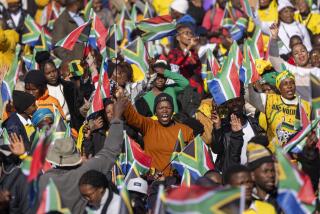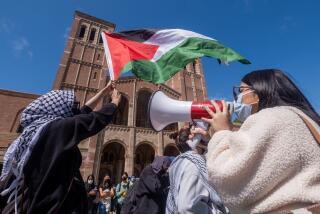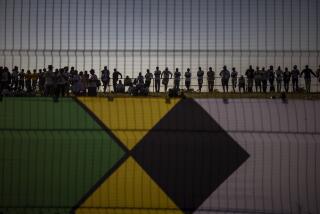Black Youths Catalyze S. African Unrest : ‘Angry Generation’ Prepared to Fight and Die to End Apartheid
SOWETO, South Africa — When Vuzi throws a rock at the police armored cars that patrol his neighborhood, he says, it is really just for practice.
“Soon we will have grenades,” he said the other day, “and then the revolution will really begin.”
Vuzi was smiling when he made that statement but he was not joking. And although he is only 18 years old, he is to be taken seriously, for it is the anger of black youths like Vuzi and their determination to dismantle apartheid that have kept the fires raging in South Africa for the last year.
“We are going to bring this apartheid system down,” he continued. “We may die in the struggle--we know that, and we accept it--but we are resolved that apartheid will not continue into another generation.”
Vuzi belongs to the “angry generation,” as a black newspaper columnist has dubbed the alienated and increasingly radical youths who seem intent on tearing the country apart--if that is what it takes to end South Africa’s system of racial separation and minority white rule.
“Apartheid must be destroyed, and every day the whites delay, promising this reform or that but trying to hold onto power, increases our commitment to the revolution,” Vuzi said. “The time for compromise is slipping away very, very quickly--it truly has been wasted--and we now count what is left not in years or even months but weeks, and soon maybe just days. . . .
“Oh, we know that victory will not come tomorrow, but the conviction is growing among our youth and among our parents that we will have to fight to take back from the white man what is ours. And once we begin this war--for that is what it will be--we will not quit until we have won.”
As Vuzi, a bright, articulate, intense youth, explained this anger that is shaking South Africa as nothing has before, his “comrades,” as they call one another, spoke in earnest agreement, amplifying Vuzi’s words into a warning to the nation’s 4.9 million whites and a challenge to the older leadership of its 25 million blacks.
“We will not accept what our fathers and mothers have accepted, what our grandparents accepted. Nor will we go into exile as our brothers did 10 years ago,” said another student, Fanyana, 19, who like Vuzi, asked that his surname not be used to avoid police retribution.
“Reforms might have pleased our parents, satisfied our brothers, but we are convinced that only a revolution can destroy this system of apartheid, and that is what we are committed to. A revolution will sweep away all who oppose it, be they whites or blacks who have some vested interest in the present system.”
Another, a 19-year-old named Butterscotch, punched the air with his clenched fist and declared, “Siyayinyova, siyayinyova. “
“Siyayinyova”--”We shall destroy”--is quickly overtaking all the other political slogans chanted by the youths of Soweto and South Africa’s other black townships, summing up the anger, the alienation and the determination to overthrow the much-hated “system,” as apartheid and all it has spawned is called.
“Their alienation is almost total, and their anger knows no bounds in its expression,” said Bishop Simeon Nkoane, the Anglican suffragan bishop for the explosive East Rand region outside Johannesburg. “We are quickly running out of time when we have a choice between revolution and reform, between violence and nonviolence . . . because the youths have run out of patience and because they are taking charge.
“One may say these kids don’t fully understand what they are saying, that they don’t realize the full consequences of their actions, that they do not truly want a revolution, but denial is no way to cope with reality and it will not stop what is coming.”
Like Bishop Desmond Tutu, the Anglican bishop of Johannesburg and the 1984 winner of the Nobel Peace Prize, Nkoane is frightened by the “sheer recklessness” of black youths.
“Their anger is probably the last warning we will get,” Nkoane said. “It is building rapidly, like steam in a boiler and unless we all--the black community, the white community, government, business, everyone--act quickly it will explode.”
725 People Killed
After more than a year of civil unrest in which at least 725 people, most of them black, have been killed, such warnings might seem unnecessary, but Tutu, Nkoane and other black leaders say that whites, particularly the government, are underestimating both the intensity and the extent of this rage and are moving too slowly, if at all, in their response to it.
“What we are getting,” Tutu said not long ago, “are piecemeal reforms, really talk of reforms, when what we need is the rapid and complete dismantling of apartheid. If this unrest is to stop, people must be given hope to replace the despair that now fills them. If the violence is to stop, then people must see that nonviolence works, that it can bring real change. . . .
“I preach nonviolence, I counsel patience, I urge reconciliation, I pray for peace . . . and these kids look at me and say, ‘Hey, man, what an old fool! He prays for peace, and (President) P. W. Botha sends him the army. He preaches nonviolence, and the police just beat us up. He says be patient, and the state president says we will reform this or that, but not too fast. What, they ask, have I to show for nonviolence? At best, a few crumbs.’ ”
Two-Thirds Back Violence
Nearly two-thirds, 63%, of urban black adults now support the use of violence to achieve political change, according to a survey by the government’s Human Sciences Research Council, and 80% believe that peaceful “compromise (on sharing power with whites in a multiracial state) is no longer possible.”
For 13 months, the anger of black youths has kept the country in turmoil, and all the government’s efforts, from police crackdowns to promises of reform, appear only to have spread the unrest. Few black communities are free from the unrest that a year ago was confined to major urban areas. In one black ghetto township after another, the parents say, “the kids have taken over.”
It is black youths, now joined by Colored, or mixed-race, youths in the Cape Town area, who fight almost daily battles with the police and army, using stones, firebombs and other homemade weapons.
It is black youths who enforce consumer boycotts, black youths who make sure that when a general strike is called no black goes to work. And it is black youths who are executing people seen as “sellouts,” whose burned bodies are found with smoldering tires around their necks.
“The kids have found that they can defy the government, that they can resist all its power and might and, if they marshal their forces, maybe they can bring it down,” Silas Nkanunu, a black lawyer in Port Elizabeth, said. “Power is quickly passing from the hands of us middle-aged moderates to youthful radicals who feel they have little or nothing to lose and maybe everything to gain from revolution.”
Steve Tshwete, 47, a regional president of the United Democratic Front, a coalition of anti-apartheid groups, acknowledges that “we must translate this anger into action . . . by organizing, by mobilizing, by attacking the system until we bring it down.”
“We have no desire to create a generation of martyrs,” he said recently in East London, after emerging briefly from hiding, “but this generation will not pass on to its children this system of apartheid. . . . We will just not resist apartheid, we will fight it. The time is coming when, if we have guns and grenades, we will fight it with guns and grenades, and if we don’t have guns, we will fight it with stones and sticks and whatever else we can lay our hands on.”
Not all black youths, of course, are ready to storm the citadels of white power in Pretoria, Johannesburg, Cape Town and other cities. Some high school students have braved the taunts and attacks of other youths to attend classes during school boycotts.
Many continue to respect their parents and community elders and even adhere to tribal traditions. A few have risked their lives to save people accused of collaborating with the white regime. But their anger seems no less.
“My mother and father are wrong in not fighting the system,” Sello Zwane, 22, a college student, said, “but I still owe them respect and understanding. . . . I personally feel that the new slogan, ‘Liberation now, education later,’ is very short-sighted. We must do both, proceed on both tracks at once, or we will not be able to run our Azania (the name many blacks give to South Africa) once we take it over. I have no illusions about reform, but revolution is a long and difficult process, as Lenin and Mao have taught us.”
Some older blacks are frightened by what anger is doing to the new generation.
“Not even an act of God seems able to stop this thing,” Aggrey Klaaste, a columnist for the black newspaper Sowetan, wrote after seeing the execution of a black who supposedly sold out to the government. “If there is one thing that South Africa will stand accused of in the future, it is turning these lovely kids into monsters.”
The alienation and the anger of young black South Africans is bred in the bleak ghettoes where they were born and have grown up.
A Bleak Best of Places
“For a black, Soweto is the best of places--and look at it,” Vuzi said during a tour of this black city of perhaps 2 million people about 10 miles southwest of downtown Johannesburg. “We do, it is true, have our own suburbs for black millionaires, but we have thousands upon thousands more living in little four-room matchbox houses. Ninety percent of the kids never finish school.
“The cops, if they don’t like you--and they don’t like most blacks--can beat you with absolute impunity. To run it all, we have a bunch of government stooges, sellouts who are in it for the money or the power, and don’t give a damn about their people. And if we make the slightest protest, just a little peep, we get put in jail. That’s Soweto. And in other places, it is much, much worse.”
Some of those places:
Duduza, east of Johannesburg, with its bucket toilets; Daveyton, where 100,000 people are jammed into 12,000 of those matchbox houses; Zwide and New Brighton, outside Port Elizabeth, where male unemployment is roughly 50%; Duncan Village, in East London, where the police shot and killed more than 30 people in a week last month; the barren tribal homelands of Ciskei and Transkei, where conditions are so bad, unemployment so widespread and starvation so common that thousands of workers migrate to the urban townships for what little work can be found.
All these conditions have contributed to the unrest of the past year. Sipho, another of Vuzi’s classmates, said: “We have more at stake in this society than anyone else. We have our whole lives before us and we don’t want to live them under apartheid. This is our country, and we want to change it. . . . “
But without a strategy, aside from the announced call by the African National Congress, the leading black opposition group, to make the country “ungovernable,” the struggle is diffuse and the goals too broad for easy achievement.
The young people’s success in setting their own townships on fire has given them the feeling that if they can only get guns from the African National Congress and help from its guerrillas, they can bring down the system they so hate.
But Ken Owen, a white newspaper columnist, wrote after a rare visit to some of the most troubled black and Colored townships:
“Isolated, segregated, undereducated, they don’t know that they are simply the cannon fodder. They don’t understand that their ‘revolution’ is penned into the ghettoes because it has no chance of breaking out. They don’t begin to imagine the immense depth of resources held in reserve by the state. They can’t make the leap of imagination from sjamboks (whips) to helicopter gunships and from rubber bullets to tanks. They understand nothing of the organization of an industrial society, or the vulnerability of urban community to any breakdown in ‘the system.’ ”
The main organ for their struggle was the six-year-old Congress of South African Students, known as COSAS, which was one of the major affiliates of the United Democratic Front--until Louis le Grange, the minister of law and order, banned it last month.
Group Banned, Ideas Remain
“They banned COSAS, but they cannot ban the ideas and spirit behind it,” said Sipho, who belonged to the group for four years.
This is not disputed in government circles, but officials argue that COSAS had become a revolutionary organization and, in Le Grange’s view, had to be broken up before it translated more of the anger of black youths into action.
Efforts are under way to establish a new youth organization to take the place of COSAS, but for the time being its former members are meeting in small, clandestine groups--cells that are likely to shape black politics in coming years.
Their orientation, say participants here and in other areas, is toward revolution, not reform, toward overthrowing the present system, getting power and establishing a new political, economic and social order in South Africa.
Most are strongly socialist in outlook, equating capitalism with white exploitation. Most are highly critical of the emerging black middle class--their parents in many cases--for losing their militancy and developing too great a stake in the stability that reform would give rather than in revolution.
A black journalist who has covered these activities said: “If you want to turn a meeting upside down, just ask, ‘Do we need the whites? Do we want them?’ The majority will say ‘no, or let them stay on our sufferance,’ but there is still a significant minority who will argue that this is the whites’ country, too, and we do not want to drive those who do not oppose us into the sea or to wreck our economy.
“What is new is the rapid disappearance of the good will that we blacks had in abundance toward whites as people, not oppressors, until at least late last year. Older folks still have it, but among the young that good will is being replaced with hate--a deep, strong, dangerous hatred.”
More to Read
Sign up for Essential California
The most important California stories and recommendations in your inbox every morning.
You may occasionally receive promotional content from the Los Angeles Times.










